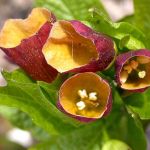| Common Name: |
Japanese Bella-Donna |
| Other Names: |
Scopolia |
| Botanical Name: |
Scopolia carniolica |
| Genus: |
Scopolia |
| Family: |
Solanaceae |
| Native Locations: |
C and SE Europe, and the Caucacus |
| Cultivation: |
Well-drained, moist, rich, neutral to slightly alkaline soil in shade. |
| Propagation: |
By seed sown in autumn; by division in spring. |
| Harvest: |
Rhizomes are lifted in autumn and processed for extraction of alkaloids. |
| Height: |
6cm (24in) |
| Width: |
60cm (24in) |
| Hardiness: |
Z5-8 |
| Parts Used: |
Rhizomes |
| Properties: |
A narcotic, warming herb that dilates the pupils, relaxes spasms, and relieves pain. |
| Medicinal Uses: |
Internally for spasms of the gastrointestinal tract, bile ducts, and urinary tract. Also in Chinese medicine, for chronic diarrhea, dysentery, stomachache, and manic-depressive states. Mainly as a source of hyoscine, and sometimes as a substitute for Atropa bella-donna (See, Deadly Nightshade) notably in the manufacture of belladonna plasters, and for Hyoscyamus niger (See, Henbane). |
| Warning: |
Toxic if eaten.
Contraindicated for children under 6, and for a number of clinical conditions.
For internal use by qualified practioners only.
This herb and its alkaloids are subject to legal restrictions in some countries. |
| Bibliography: |
Encyclopedia of Herbs by Deni Brown Copyright © 1995, 2001 Dorling Kindersley Limited. pp 363-364 |

